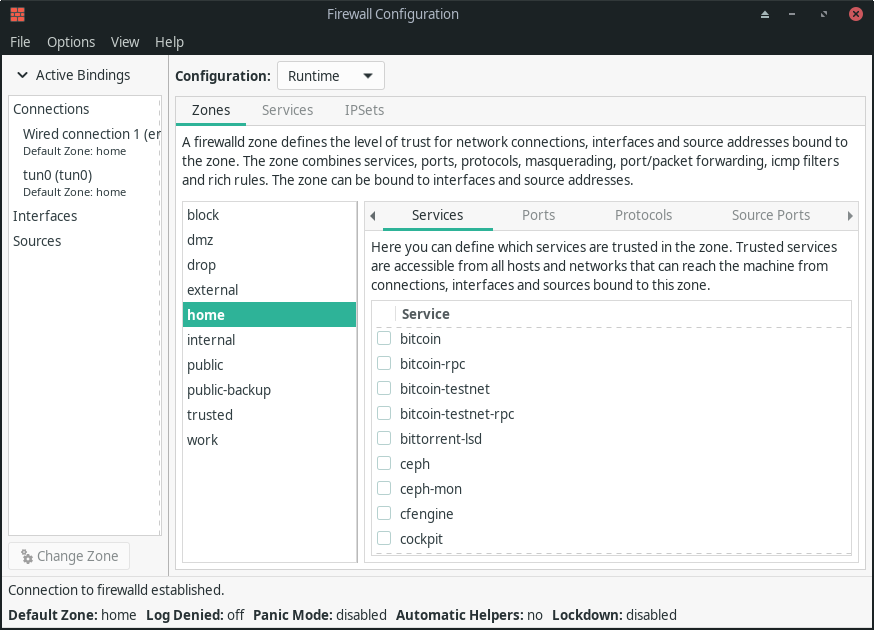Installing Firewalld grants a long list of commands available for configuring iptables rules. But there are a few tasks you should understand to get started with securing your server.
Below we cover:
Firewalld is pre-installed with our Cloud Server Hosting.
Basic Firewalld Commands
Firewalld Status
These Systemd and Firewalld commands affect whether or how Firewalld is running on your system.
Start Firewalld for the current session:
sudo systemctl start firewalld
Enable Firewalld to always start at server boot:
sudo systemctl enable firewalld
Stop Firewalld for the current session:
sudo systemctl stop firewalld
Disable Firewalld from starting at boot:
sudo systemctl disable firewalld
Check whether Firewalld is running:
sudo systemctl status firewalld
Check the Firewalld state – similar to systemctl status:
sudo firewall-cmd --state
The output will be running or not running.
Runtime Firewalld Configuration to Permanent
- Runtime changes are temporary and removed when the firewall restarts.
- Permanent changes are stored in configuration files.
Save --runtime changes to your permanent configuration:
sudo firewall-cmd --runtime-to-permanent
Reload Firewalld
Reload Firewalld to merge --permanent rules to the runtime configuration (doesn’t close current connections):
Reloading will remove –runtime changes to apply the –permanent configuration.
sudo firewall-cmd --reload
Firewalld Zones
Firewalld zones are predefined whitelist combinations to easily apply to your system.
Default Firewalld zones:
block dmz drop external home internal public trusted work
View all Firewalld zones available:
sudo firewall-cmd --get-zones
You can also view the raw zone files:
ls /etc/firewalld/zone/
See currently used zones:
sudo firewall-cmd --get-active-zones
Change the current Firewalld zone (e.g. public):
sudo firewall-cmd --change-zone=public
To apply a change to a specific zone, add the following to the end of the command (e.g. public):
--zone=public
Manage Services
Predefined Firewalld services use a name in lieu of port number and protocol (TCP or UDP) for easier management.
List available services to whitelist:
sudo firewall-cmd --get-services
List currently whitelisted services:
sudo firewall-cmd --list-services
Whitelist a service for runtime only in the current zone (e.g. http):
sudo firewall-cmd --add-service=http
Whitelist a service permanently in the current zone:
sudo firewall-cmd --add-service=http --permanent
Whitelist a service permanently in a specific zone:
sudo firewall-cmd --zone=public --add-service=http --permanent
Remove a service permanently from a specific zone (e.g. dhcpv6-client):
sudo firewall-cmd --remove-service=dhcpv6-client --permanent
Manage Ports
Any ports not listed as a predefined service can be managed via port/protocol (e.g. 80/http).
List currently open ports:
sudo firewall-cmd --list-ports
List whitelisted ports on a specific zone:
sudo firewall-cmd --zone=public --list-ports
Open a port with a specified protocol in runtime only (e.g. Mattermost):
sudo firewall-cmd --add-port=8065/tcp
Open a port permanently:
sudo firewall-cmd --add-port=8065/tcp --permanent
Remove a port in runtime only:
sudo firewall-cmd --zone=public --remove-port=8065/tcp
Remove a port permanently:
sudo firewall-cmd --zone=public --remove-port=8065/tcp --permanent
Panic Mode
Panic mode closes and blocks all incoming and outgoing connections on the machine.
If you run this while remotely connected to a machine (e.g. SSH), your session will drop and you’ll have to restart the server to regain access and reset panic mode.
sudo firewall-cmd --panic-on
Check panic mode status:
sudo firewall-cmd --query-panic
It should simply state no.
Firewalld Files
View system configuration files which overwrite default configurations.
ls /etc/firewalld
View default IMCP, service, and zone configurations.
Changes to these files are overwritten during firewalld updates.
ls /usr/lib/Firewalld
Firewall-config Desktop Application
Users installing Firewalld on a Linux desktop environment can install the firewall-config GUI application to configure firewall zones on that machine.

Have any questions about Firewalld? Ask in our Community Support Center.
